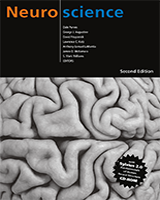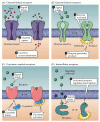By agreement with the publisher, this book is accessible by the search feature, but cannot be browsed.
NCBI Bookshelf. A service of the National Library of Medicine, National Institutes of Health.
Purves D, Augustine GJ, Fitzpatrick D, et al., editors. Neuroscience. 2nd edition. Sunderland (MA): Sinauer Associates; 2001.

Neuroscience. 2nd edition.
Show detailsRegardless of the nature of the initiating signal, the cellular responses are determined by the presence of receptors that specifically bind the signaling molecules. Binding of signal molecules causes a conformational change in the receptor, which then triggers the subsequent signaling cascade. Given that chemical signals can act either at the plasma membrane or within the cytoplasm (or nucleus) of the target cell, it is not surprising that receptors are found on both sides of the plasma membrane.
The receptors for impermeant signal molecules are membrane-spanning proteins that include components both outside and inside the cell surface. The extracellular domain of such receptors includes the binding site for the signal, while the intracellular domain activates intracellular signaling cascades after the signal binds. A large number of these receptors have been identified and are grouped into three families defined by the mechanism used to transduce signal binding into a cellular response (Figure 8.4A-C).

Figure 8.4
Categories of cellular receptors. Membrane-impermeant signaling molecules can bind to and activate either channel-linked receptors (A), enzyme-linked receptors (B), or G-protein-coupled receptors (C). Membrane permeant signaling molecules activate intracellular (more...)
Channel-linked receptors (also called ligand-gated ion channels) have the receptor and transducing functions as part of the same protein molecule. Interaction of the chemical signal with the binding site of the receptor causes the opening or closing of an ion channel pore in another part of the same molecule. The resulting ion flux changes the membrane potential of the target cell and, in some cases, can also lead to entry of Ca2+ ions that serve as a second messenger signal within the cell. Good examples of such receptors are the neurotransmitter receptors described in Chapter 7.
Enzyme-linked receptors also have an extracellular binding site for chemical signals. The intracellular domain of such receptors is an enzyme whose catalytic activity is regulated by the binding of an extracellular signal. The great majority of these receptors are protein kinases, often tyrosine kinases, that phosphorylate intracellular target proteins, thereby changing the physiological function of the target cells. Noteworthy members of this group of receptors include the Trk family of neurotrophin receptors (see Chapter 23) and other receptors for growth factors.
G-protein-coupled receptors regulate intracellular reactions by an indirect mechanism involving an intermediate transducing molecule, called the GTP-binding proteins (or G-proteins). Because these receptors all share the structural feature of crossing the plasma membrane seven times, they are also referred to as 7-transmembrane receptors (or metabotropic receptors; see Chapter 7). Hundreds of different G-protein-linked receptors have been identified. Well-known examples include the β-adrenergic receptor, the muscarininc type of acetylcholine receptor, metabotropic glutamate receptors, receptors for odorants in the olfactory system, and many types of receptors for peptide hormones. Rhodopsin, a light-sensitive 7-transmembrane protein in retinal photoreceptors, is another form of G-protein-linked receptor (see Chapter 11).
Intracellular receptors are activated by cell-permeant or lipophilic signaling molecules (Figure 8.4D). Many of these receptors lead to the activation of signaling cascades that produce new mRNA and protein within the target cell. Often such receptors comprise a receptor protein bound to an inhibitory protein complex. When the signaling molecule binds to the receptor, the inhibitory complex dissociates to expose a DNA-binding domain on the receptor. This activated form of the receptor can then move into the nucleus and directly interact with nuclear DNA, resulting in altered transcription. Some intracellular receptors are located primarily in the cytoplasm, while others are in the nucleus. In either case, once these receptors are activated they can affect gene expression by altering DNA transcription.
- Receptor Types - NeuroscienceReceptor Types - Neuroscience
Your browsing activity is empty.
Activity recording is turned off.
See more...